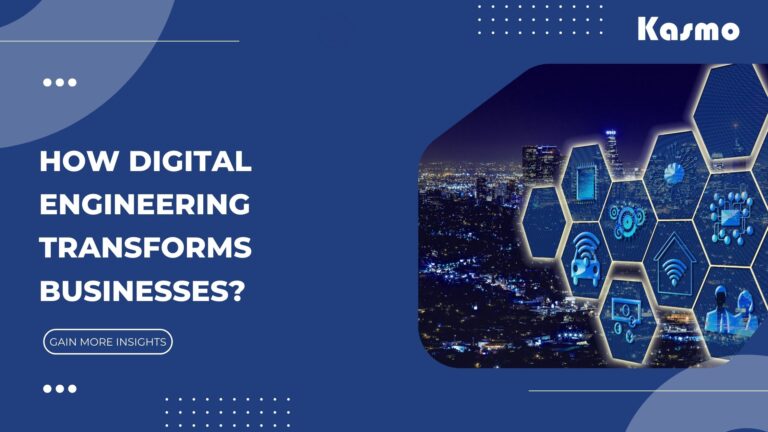The dynamic technology landscape disrupted how enterprises deliver customer experience. New challenges such as skill shortage, supply chain issues, and rising costs are pushing businesses to evolve their design and production strategies to achieve cost-effectiveness and meet customer expectations. Digital engineering has revolutionizing potential to transform the way businesses attain visibility, advance their product design, save costs and serve customers.
What is Digital Engineering?
Digital engineering is a holistic approach to designing and developing systems and applications using digital technologies. By blending in the power of digital automation, content creators, data analytics, artificial intelligence (AI), digital twin technology, and machine learning, digital engineering allows the creation of new digital products or even 360-degree novel solutions in its entirety.
Digital engineering helps:
- Develop drawings, simulations, and 3D models for data collection and testing.
- Innovate product designs based on the outcomes of simulations and 3D models.
- Simplify the design and integration of models using data insights.
- Save project time and cost by identifying improvements during the initial phases of the project.
- Achieve enhanced coordination between design, engineering, and construction.
- Reduce the risk and improve the project delivery speed.
Digital Engineering in Software
Digital engineering helps an array of industries – automotive, construction, software, and more. It allows designers to explore possibilities and develop innovative solutions in a virtual environment. Applying digital engineering principles to software development results in software product engineering.
Software product engineering, or product engineering in short – is an umbrella term that encompasses end-to-end stages of software product development – design, development, testing, and deployment.
Businesses can achieve better outcomes by empowering and guiding their design teams with software product engineering tools and best practices.

Digital Engineering Possibilities
The core purpose of digital engineering is to extend the scope of innovation at less risk, faster speeds, and greater accuracy. By combining their business goals with digital engineering best practices, organizations can open up to endless possibilities as listed below:
- Boost employee productivity by freeing them from traditional tedious resource-intensive tasks and allowing them to focus on high-value commitments.
- Design and visualize every innovative model in a virtual environment and use the virtual prototypes to assess the risks and enhancements that could save time and resources.
- Solve a diverse spectrum of pressing concerns ranging from product innovation to environmental issues with data-based modeling.
- Perform rapid testing at a faster speed and saves time on working with inefficient solutions.
- Digital twin allows testing at a faster speed with minimal risks and an understanding of the intricacies of product design.
- Businesses can attain resource and asset efficiency as digital engineering enables engineers to create high-value designs at minimal risks and costs.
- Attain clear visibility into the workflow with minimal friction and delays to arrive at the targeted outcomes.
The Core Pillars of Digital Engineering
Thanks to digital engineering, designers can bring ideas to life in a virtual world faster and at reduced costs. What imparts the unique power to digital engineering aside from the cutting-edge technology it involves are its core pillars, as briefed here:
1. Data:
Data is the heart of digital transformation. Data capture and manipulation are the first steps to arriving at digital engineering outcomes. Kasmo has helped global businesses to unlock the power of data playing a vital role in the success of their digital engineering capabilities.
2. Collaboration:
As it makes data available to all individuals, collaboration is yet another fruitful outcome of digital engineering. By digitizing every piece of information required for the modeling, teams can access any data as and when necessary, thus making information siloes a thing of the past. It creates collaborative ecosystems inviting departments to identify, generate, analyze and validate ideas to refine the virtual prototype.
3. Engineering Principles:
Digital engineering augments the processes without disturbing the fundamental engineering principles. It infuses the power of data, virtualization, and a sandbox environment where engineers can design and improve digitally-driven models that offer time and resource-saving on the go.
4. Innovation:
Traditional engineering mandated the design of physical prototypes to analyze and arrive at improvements. The scope for innovation was limited along with time, cost, and resource intensive.
On the contrary, digital engineering allows designers to harness the power of cloud technologies and data analytics to generate multiple models and test them simultaneously in the sandbox.
Such a design and production environment allow infinite scope for innovation enabling companies to enhance their creations or invent revolutionary innovations.
The scope for innovation comes in handy, especially when dealing with inventive solutions with high investments and risks included.
The Future Ahead
With the bounty of benefits that digital engineering presents, it can be overwhelming to analyze the right place to start in your organization. Kasmo experts can provide a vivid view of the best-fit organizational operations and processes to kickstart your digital engineering adaption. Send us a message to know how our role can be pivotal in your business digital transformation. Connect with us on LinkedIn.

